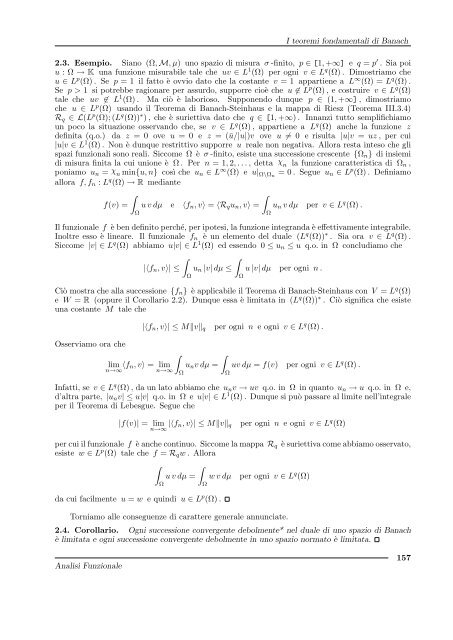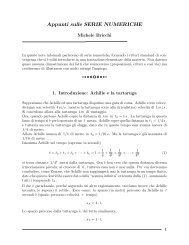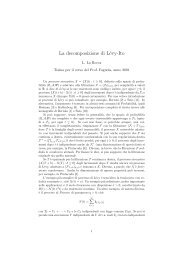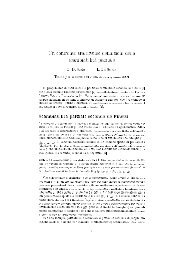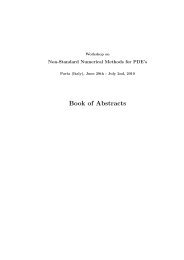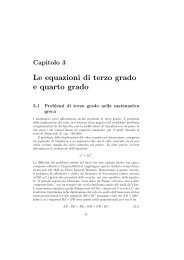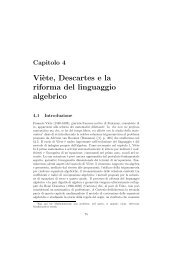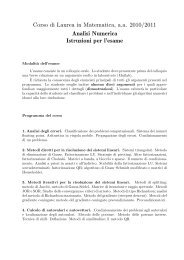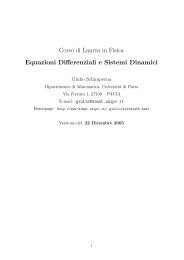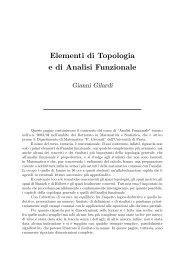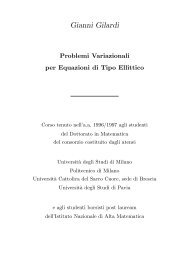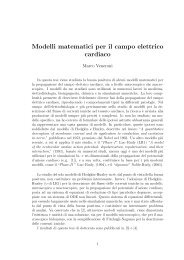G. Gilardi, Analisi Funzionale - Dipartimento di Matematica
G. Gilardi, Analisi Funzionale - Dipartimento di Matematica
G. Gilardi, Analisi Funzionale - Dipartimento di Matematica
You also want an ePaper? Increase the reach of your titles
YUMPU automatically turns print PDFs into web optimized ePapers that Google loves.
I teoremi fondamentali <strong>di</strong> Banach<br />
2.3. Esempio. Siano (Ω, M, µ) uno spazio <strong>di</strong> misura σ -finito, p ∈ [1, +∞] e q = p ′ . Sia poi<br />
u : Ω → K una funzione misurabile tale che uv ∈ L1 (Ω) per ogni v ∈ Lq (Ω) . Dimostriamo che<br />
u ∈ Lp (Ω) . Se p = 1 il fatto è ovvio dato che la costante v = 1 appartiene a L∞ (Ω) = Lq (Ω) .<br />
Se p > 1 si potrebbe ragionare per assurdo, supporre cioè che u �∈ Lp (Ω) , e costruire v ∈ Lq (Ω)<br />
tale che uv �∈ L1 (Ω) . Ma ciò è laborioso. Supponendo dunque p ∈ (1, +∞] , <strong>di</strong>mostriamo<br />
che u ∈ Lp (Ω) usando il Teorema <strong>di</strong> Banach-Steinhaus e la mappa <strong>di</strong> Riesz (Teorema III.3.4)<br />
Rq ∈ L(Lp (Ω); (Lq (Ω)) ∗ ) , che è suriettiva dato che q ∈ [1, +∞) . Innanzi tutto semplifichiamo<br />
un poco la situazione osservando che, se v ∈ Lq (Ω) , appartiene a Lq (Ω) anche la funzione z<br />
definita (q.o.) da z = 0 ove u = 0 e z = (ū/|u|)v ove u �= 0 e risulta |u|v = uz , per cui<br />
|u|v ∈ L1 (Ω) . Non è dunque restrittivo supporre u reale non negativa. Allora resta inteso che gli<br />
spazi funzionali sono reali. Siccome Ω è σ -finito, esiste una successione crescente {Ωn} <strong>di</strong> insiemi<br />
<strong>di</strong> misura finita la cui unione è Ω . Per n = 1, 2, . . . , detta χn la funzione caratteristica <strong>di</strong> Ωn ,<br />
poniamo un = χn min{u, n} così che un ∈ L∞ (Ω) e u| Ω\Ωn = 0 . Segue un ∈ Lp (Ω) . Definiamo<br />
allora f, fn : Lq (Ω) → R me<strong>di</strong>ante<br />
�<br />
�<br />
f(v) = u v dµ e 〈fn, v〉 = 〈Rqun, v〉 = un v dµ per v ∈ L<br />
Ω<br />
q (Ω) .<br />
Ω<br />
Il funzionale f è ben definito perché, per ipotesi, la funzione integranda è effettivamente integrabile.<br />
Inoltre esso è lineare. Il funzionale fn è un elemento del duale (Lq (Ω)) ∗ . Sia ora v ∈ Lq (Ω) .<br />
Siccome |v| ∈ Lq (Ω) abbiamo u|v| ∈ L1 (Ω) ed essendo 0 ≤ un ≤ u q.o. in Ω conclu<strong>di</strong>amo che<br />
�<br />
�<br />
|〈fn, v〉| ≤<br />
un |v| dµ ≤<br />
Ω<br />
Ω<br />
u |v| dµ per ogni n .<br />
Ciò mostra che alla successione {fn} è applicabile il Teorema <strong>di</strong> Banach-Steinhaus con V = L q (Ω)<br />
e W = R (oppure il Corollario 2.2). Dunque essa è limitata in (L q (Ω)) ∗ . Ciò significa che esiste<br />
una costante M tale che<br />
Osserviamo ora che<br />
lim<br />
n→∞ 〈fn,<br />
�<br />
v〉 = lim<br />
n→∞<br />
|〈fn, v〉| ≤ M�v�q per ogni n e ogni v ∈ L q (Ω) .<br />
Ω<br />
�<br />
unv dµ =<br />
Ω<br />
uv dµ = f(v) per ogni v ∈ L q (Ω) .<br />
Infatti, se v ∈ L q (Ω) , da un lato abbiamo che unv → uv q.o. in Ω in quanto un → u q.o. in Ω e,<br />
d’altra parte, |unv| ≤ u|v| q.o. in Ω e u|v| ∈ L 1 (Ω) . Dunque si può passare al limite nell’integrale<br />
per il Teorema <strong>di</strong> Lebesgue. Segue che<br />
|f(v)| = lim<br />
n→∞ |〈fn, v〉| ≤ M�v�q per ogni n e ogni v ∈ L q (Ω)<br />
per cui il funzionale f è anche continuo. Siccome la mappa Rq è suriettiva come abbiamo osservato,<br />
esiste w ∈ Lp (Ω) tale che f = Rqw . Allora<br />
� �<br />
u v dµ = w v dµ per ogni v ∈ Lq (Ω)<br />
da cui facilmente u = w e quin<strong>di</strong> u ∈ L p (Ω) .<br />
Ω<br />
Torniamo alle conseguenze <strong>di</strong> carattere generale annunciate.<br />
Ω<br />
2.4. Corollario. Ogni successione convergente debolmente* nel duale <strong>di</strong> uno spazio <strong>di</strong> Banach<br />
è limitata e ogni successione convergente debolmente in uno spazio normato è limitata.<br />
<strong>Analisi</strong> <strong>Funzionale</strong><br />
157


